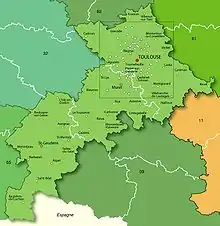Haute-Garonne
Haute-Garonne (French pronunciation: [otɡaʁɔn]; Occitan: Nauta Garona; English: Upper Garonne) is a department in the Occitanie region of Southwestern France. Named after the Garonne River, its prefecture and main city is Toulouse, the country's fourth-largest. In 2016, it had a population of 1,348,183.
Haute-Garonne
| |
|---|---|
.jpg.webp) | |
 Flag  Coat of arms | |
 Location of Haute-Garonne in France | |
| Coordinates: 43°25′N 1°30′E | |
| Country | France |
| Region | Occitanie |
| Prefecture | Toulouse |
| Subprefectures | Saint-Gaudens Muret |
| Government | |
| • President of the Departmental Council | Georges Méric (PS) |
| Area | |
| • Total | 6,309 km2 (2,436 sq mi) |
| Population (2016) | |
| • Total | 1,348,183 |
| • Rank | 13th |
| • Density | 210/km2 (550/sq mi) |
| Time zone | UTC+1 (CET) |
| • Summer (DST) | UTC+2 (CEST) |
| Department number | 31 |
| Arrondissements | 3 |
| Cantons | 27 |
| Communes | 586 |
| ^1 French Land Register data, which exclude estuaries and lakes, ponds and glaciers larger than 1 km2 | |
History
Haute-Garonne is one of the original 83 departments created during the French Revolution on 4 March 1790. It was created from part of the former provinces of Languedoc and Guyenne/Gascony.
The department was originally larger. The reduction in its area resulted from an imperial decree dated 21 November 1808 and which established the neighbouring department of Tarn-et-Garonne, to the north. The new department, created in response to the pleadings of various locally powerful politicians, took territory from five surrounding departments including Haute-Garonne. The districts lost to Tarn-et-Garonne in 1808 were those of Montech and Castelsarrasin.
Geography

Haute-Garonne is part of the current region of Occitanie and is surrounded by the departments of Hautes-Pyrénées, Gers, Tarn-et-Garonne, Tarn, Aude, and Ariège. It also borders Spain in the south (province of Lleida and province of Huesca).
The department is crossed by the upper course of the Garonne river (hence the name) for nearly 200 kilometers (120 mi). The borders of the department follow the river. The Garonne enters France from Spain at the town of Fos, and goes through Toulouse and leaves the department. The extreme south of the department lies in the Pyrenees mountain range and is very mountainous. The highest elevation is the Peak of Perdiguère, at 3,222 meters (10,571 feet) above sea level.
Politics
This department was the political base of former Prime Minister Lionel Jospin.
Departmental Council of Haute-Garonne
The Departmental Council of Haute-Garonne comprises 54 seats. In the 2015 departmental elections, the Socialist Party (PS) won 48 seats. The Republicans secured the remaining 6 seats. The President of the Departmental Council has been Georges Méric (PS) since 2015.
| Party | Seats | |
|---|---|---|
| • | Socialist Party | 48 |
| The Republicans | 6 | |
Members of the National Assembly
Haute-Garonne elected the following members of the National Assembly during the 2017 legislative election:
Demographics
The inhabitants of the department are called Haut-Garonnais. The greatest population concentration is around Toulouse. The south of the department is quite sparsely populated. More than a million people inhabited the department at the last census in 1999. Young people are well represented with 55% of the population under the age of 40 and of those, 16% are between the ages of 20 and 29. This is because Toulouse is a university town.
The largest towns are:
| Commune | Population (1999) | Commune | Population (1999) |
|---|---|---|---|
| Toulouse | 390,350 | Colomiers | 28,538 |
| Tournefeuille | 22,758 | Muret | 20,735 |
| Blagnac | 20,586 | Plaisance-du-Touch | 14,164 |
| Cugnaux | 12,997 | L'Union | 12,141 |
| Balma | 11,944 | Ramonville-Saint-Agne | 11,696 |
| Saint-Orens-de-Gameville | 11,142 | Saint-Gaudens | 10,845 |
| Castanet-Tolosan | 10,250 | Portet-sur-Garonne | 8,737 |
| Saint-Jean | 8,362 | Villeneuve-Tolosane | 8,252 |
| Revel | 7,985 | Castelginest | 7,735 |
| Pibrac | 7,440 | Fonsorbes | 6,909 |
Tourism
Main sights
Haute-Garonne's main sights include:
 Capitole de Toulouse at night
Capitole de Toulouse at night Château de Laréole
Château de Laréole Pyrenees seen from Bagnères-de-Luchon
Pyrenees seen from Bagnères-de-Luchon

Winter sports
The department has four ski resorts:
- Peyragudes (1600 m -2450 m), 55 km of slopes
- Luchon-Superbagnères (1440 m - 2260 m), 30 km of slopes
- Le Mourtis (1380 m - 1816 m), 22 km of slopes
- Bourg-d'Oueil (1350 m - 1500 m)
See also
References
External links
- (in French) General council website
- (in French) Prefecture website
- (in French) Tourism website
- (in French) Photography Panoramics 360° website